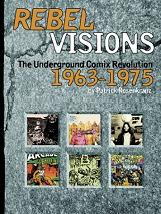
Rebel Visions: The Underground Comix Revolution 1963-1975 is quite an ironic book. The underground comix movement was born as a rejection of the conformist, capitalist values of late fifties / early sixties America, yet here it is codified as that ultimate in vacuous literature, the glossy expensive coffee table book, just another showoff item for nostalgic babyboomers, safely shrinkwrapped and non-threatening. Judging it soley on these terms would be unfair however; this is also a remarkably complete history of underground comix, with perhaps few surprises for those well versed in the history of the genre, but still providing a good overview of it. It seems to have been somewhat of a labour of love for the author, Patrick Rosenkranz, who had already published on history of underground comics, Komix Kountermedia back in 1973.
The undergound comix movement was a particularly American response to the conformity of the fifties. Comics as an art and as a commercial form had been established in the thirties and forties and was starting to break out of the kiddies ghetto in the late forties and early fifties, only for a worldwide backlash to push it back further. In the Netherlands, the government minister for education warned comics rot the brain, in France a law was enacted forbidding certain kinds of stories in comics and in America the comics code authority was established. Nothing could be published unless it carried the comics code seal of approval or it was above suspicion, like Dell's line of comics. Whereas in Europe after the backlash there was still room for some experimentating and more adult orientated comics, in America there was none. Hence the particular form the reaction against this backlash took in America, much more extreme at first than in Europe and going much further in not only rejecting the restrictions put upon comics as an artform, but also the whole business that had grown up around comics.
Underground comics evolved out of college magazines, comics fanzines and the various post-MAD Harvey Kurtzman ventures like Help and Trumb, culminating in 1968 with the publication of Zap, the first underground bestseller. Underground comics quickly multiplied and by the early seventies there were hundreds of titles published, mostly oneshots or irregularly published, sold throughout headshops and other hippie friendly stores. Though the pioneers, like Crumb, were true artists, once their comics became popular a lot of greed merchants joined the bandwagon and a lot of self indulgent shit was published, full of sexism and unfunny dope jokes. Once the inevitable crackdown on counterculture got underway properly in the mid seventies, with headshops and other selling places being closed down for drug related offenses, the underground comics boom busted, leaving behind mostly the same people who started it...
Today, underground comica have largely disappeared; sure, there's still work produced in the style of the undergrounds of the sixties/seventies, but it is largely published and distributed through the same channels as mainstream comics. As a publishing movement the underground is outdated, but it was still incredibly important in liberating American comics from its "for children" straightjacket. Its role has now been taken over by alternative and art orientated publishers like Fantagraphics (not coincidently the publisher of this book), Drawn and Quarterly, Top Shelf and others.
Rosenkranz begins the history of underground comics in 1963, because of the publication in that year of Rick Griffin's The Cartoon History of Surfing, the first true underground comic, then following it in two year chapters up until 1975. The last two chapters also look at later developments and the legacy underground comics left behind. The way he does this is by not just providing a general overview of the underground in each period, but by also following individual creators through the years. Rosenkranz wisely avoids the temptation of being comprehensive in his coverage, focusing on the major underground cartoonists for the most part, people like Robert Crumb, Spain Rodriguez, Gilbert Shelton and the like, rather than trying to namecheck every underground cartoonist who ever existed. Rosenkranz writes well and is not afraid to let the cartoonists themselves speak, quoting extensively from various interviews with them.
Despite its coffee table nature, this then is an important book for anybody interested in underground comics and I recommend it highly.
Read more about:
Patrick Rosenkranz,
underground comcis,
comics history,
book review
